Disclaimer: The information presented below is for general informational & educational purposes only. Always consult with animal professionals in case of specific concerns.
Nature has so many beautiful things. Animals with long necks are one of the miracles that nature has given to life.
It won’t be easy to name all of the animals in the world with elongated necks. Furthermore, these necks are more than just a part of their bodies; they serve various functions.
If you want to discover more about these incredible creatures, let’s dive into this article to learn in detail.
21 Amazing Animals With Long Necks
Below are the animals with long necks list. Let’s take a closer look!
#1. Giraffe
The giraffe is the world’s tallest land mammal that lives in open forests and grasslands. It is a member of the animals with patterns group that come from Giraffid family.
You can find it in Southern Africa, East Africa, or zoos in various countries worldwide.
Why do giraffes have such long necks? It possesses a long neck that may reach 6 to 8 feet long, making it appear awkward when drinking water.
It must spread its lengthy legs apart or kneel to touch the water.
This body part allows it to chew tree leaves inaccessible to other species.
Male giraffes fight one other with their long necks to express dominance and attract the female ones.

#2. Emu
Emu is one of the flightless birds on earth. It is the world’s second-biggest bird, only after the ostrich.
It is a member of the Casuariidae family and is popular in zoos worldwide.
This large flightless bird can grow approximately 6 feet tall and has an elongated neck with scant pale blue feathers.
This body part aids it in spotting oncoming and hiding predators and hazards in the high grasses of the Australian grassland.
It possesses an inflatable long neck bag in its neck that may create a loud roaring noise or other speech patterns.
#3. Ostrich
The ostrich, which includes the standard and Somali ostriches, is a well-known flightless bird.
It comes from the Struthionidae family and lives in Africa’s savannas, grasslands, open forests, and the Sahel.
This animal possesses somewhat lengthy necks that are reddish-bluish in hue. Its long, slender necks allow it to reach food that is far away.
Fortunately, this body feature allows it to spot predators lurking in the grasslands before they come across it and its nests.
This species folds its prolonged legs and keeps its neck flat on the ground when it is not battling.
Read more: 16 Birds With Long Legs You Must Know About (With Pics)
#4. Flamingo
Flamingo, including the American and Andean flamingos, is one of the birds with long beak that comes from the Phoenicopteridae family.
This animal lives in tidal flats, estuarine lagoons, or mangrove swamps. You can see it in Chile, Belize, Peru, the Galapagos Islands, and Bolivia.
The development of 19 extended neck bones termed cervical vertebrae gives this species an elongated neck.
This body part is an adaptation because it possesses long legs, which help them avoid getting wet when finding food in the shallow.
It can attack the target with pinpoint accuracy before this animal notices it. To eat and sieve aquatic food, it may tilt its head backward.
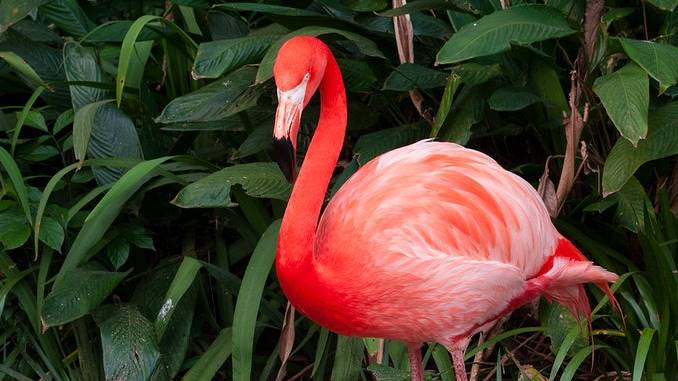
#5. Greater Rhea
The greater rhea, also called American rhea, common rhea, or grey rhea belongs to the flightless bird type in the Rheidae family.
It is popular in Argentina, South America, Brazil, Uruguay, Bolivia, and Paraguay.
This large bird looks like an emu and may grow approximately 5 feet tall. It has lengthy necks with fur.
#6. The Eastern Snake-Necked Turtles
The snake-necked turtle is a carnivorous turtle animal that feeds mainly on fish. It comes from the Chelidae family and lives throughout New Guinea and Australia.
The snake-necked turtle and its relatives boast the world’s longest necks among turtle species.
When raised over foliage or water hiding the body, its prolonged neck looks like a snake.
It may fold its neck and stretch it towards the body very quickly for approaching prey.
#7. Llama
Like the guanaco, Huacaya alpaca, Lama Glama, and Suri alpaca, Llama is a gregarious herbivorous mammal that lives in herds.
It lives in different countries worldwide, such as Australia, North America, and Europe.
The body part of this mammal is similar to that of a camel. It has a long neck to stoop down to the soil while devouring vegetative cover.
This trait allows it to view at an ideal height while walking. Some Llama may be wierd. If you are curious, you can watch this video:
#8. Great Egret
The Great Egret, also called the large egret, the common egret, the great white heron, is a type of heron from the heron Ardeidae family.
This magnificent great egret features the most extended neck among the egret types.
It also has an elongated S-shaped neck covered with white fur that is evenly dispersed.
It can stretch these things while slashing its victim with its razor-sharp beaks.
#9. Dreadnought
Dreadnought is among the giant land vertebrates. It lived on the earth 77 million years ago.
It resides in Argentina’s southern Patagonia and eats only plants.
It features a considerable body weighing over 65 tons and a 37-foot-long neck, which is enormous.
Having a bodyweight of roughly 85 feet, it has a relatively horizontal neck because the front legs are more elongated than the back legs.
This body part is significantly longer than the body size.
#10. Diplodocus
Diplodocus belongs to the herbivorous dinosaur group, which walks on four legs. It used to exist in North America on the planet about 150 million years ago.
This species possesses a 26-foot-long neck and a 45-foot-long tail, making it the longest-bodied mammal.
On the other hand, its head is just approximately 2 feet long.
As a result, it possesses a body length of about 80 feet from head to tail and a tail including roughly 80 bones.
It uses its long tail and neck to balance its 15-ton body, with its tail serving as a weapon fighting predators.
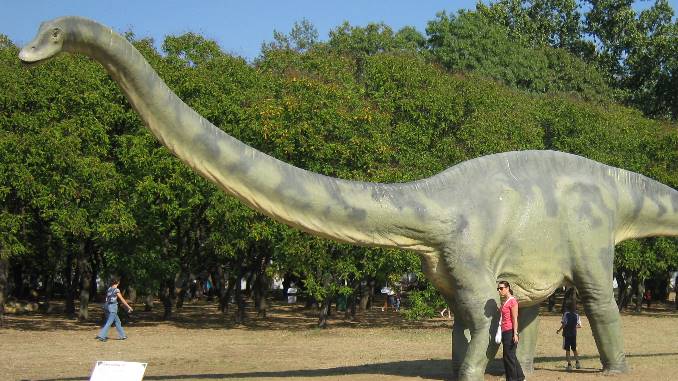
#11. Brachiosaurus
Brachiosaurus also belongs to the group of giant herbivorous dinosaurs, like Diplodocus.
It used to live in some regions such as Africa, Europe, and North America 150 million years ago.
This animal is one of the biggest among numerous varieties of giant dinosaurs.
It has a head-to-tail length of around 25 meters and a height of approximately 10 meters, and it weighs between 40 and 80 tons.
Compared to other dinosaurs having shorter necks, this species possesses a 30-foot elongated neck.
#12. King Vulture
A king vulture is a big bird from the Cathartidae family of New World vultures that eat on carrion.
You can find this terrible pet throughout South and Central America and in northern Argentina and southern Mexico in tropical lowland woods.
It possesses a prolonged neck that allows it to rummage through corpses, searching for meat and carrion.
It has no feathers on this body part to avoid bacteria attaching to the feathers while consuming carrion, typically containing microbes.
#13. Komodo Dragon
The Komodo dragon is a poisonous and predatory lizard native to Indonesia, commonly called the Komodo monitor. It is the most prominent member of the Varanidae family of lizards.
This venomous lizard may grow more than 3 meters in length and has a thick, lengthy neck designed to pull the flesh from its target.
When it runs and climbs, the tail and neck work together to support each other and its body.
#14. Anhinga
The anhinga, also called snakebird, American darter, darter, devil bird, or water turkey, belongs to the waterbird group of the Anhingidae family.
It is common in freshwater wetlands, saltwater habitats, and brackish in America.
It has a long, narrow neck and a sharp, pointed beak via which it strikes its food like fish, shrimp, aquatic invertebrates, and crayfish.
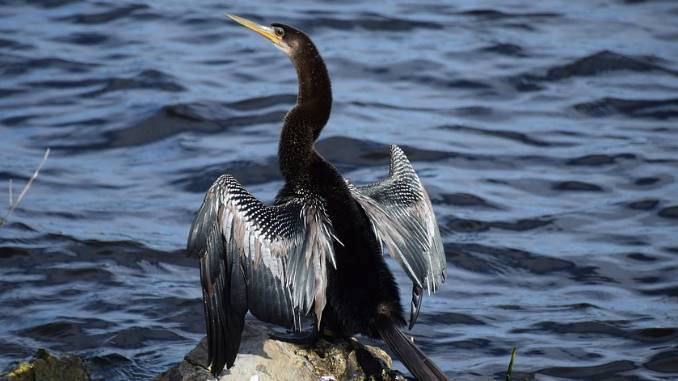
#15. Black Swan
A black swan is a big waterbird that belongs to the Anatidae family. It lives in rivers, swamps, saltwater lakes, and freshwater lakes in New Zealand and Australia.
It has the most extended neck of any swan, bent in an S form and black in hue. Thanks to its long neck, this species can access submerged aquatic plants like stoneworts, aquatic veggies, and pondweeds.
When it feels threatened, it raises its neck and spreads its wings to signify being ready to fight.
#16. Gerenuk
The gerenuk commonly called the Waller’s gazelle or giraffe gazelle is an East African herbivorous antelope.
It stands from 2 to 3.5 feet tall and has a 7-10-inch-wide neck. The elongated, thin limbs and neck distinguish this browsing antelope.
Despite its small size, it can feed on tall plants and tree leaves thanks to these parts of its body.
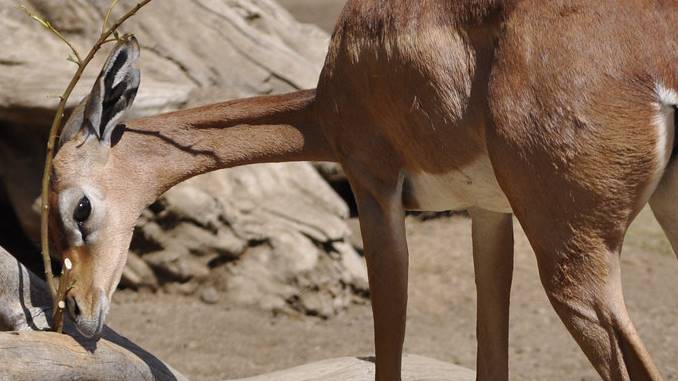
#17. Rhea
Rhea, also called American rhea, common rhea, or grey rhea is a large flightless bird in the Rheidae family.
It lives in several regions around the world like Uruguay, South America, Argentina, Paraguay, Bolivia, and Brazil.
Rhea may reach 67 inches and is distinguished by its grey-brown feather, elongated neck, and legs.
Rhea is an omnivore who eats broad-leaved, primarily vegetables and fruits.
#18. Alpaca
Alpaca is a type of camelid native to South America. It looks like a camel, but it doesn’t have any humps.
Its hairy, 3.8-foot-long neck serves different functions. Like vicuna, this gentle animal enjoys eating tree leaves.
As a result, it developed an elongated neck and legs to swallow the leaves that grew on the tops of the trees.
Besides, this body part aids in predator detection, such as mountain lions, coyotes, and bears.
#19. Jabirus
Jabirus is a long-neck wading bird inhabited in Mexico and Argentina. It is outstanding with its white plumage and its red and black neck.
While its body height from head to tail is 5 feet, its neck is approximately 2 feet long.
Jabirus belongs to a group of social birds. It prefers to live near rivers and ponds, feeding primarily on amphibians and fish.
#20. The Arabian Camel
The Arabian camel, also called dromedary, is the most elevated camel species, as it is tall, around 6.3 feet. It lives in North Africa and the Middle East.
This animal is unique thanks to its long, curved neck, furs on its throat, and one hump.
Camel is a ground feeder that has evolved into a long-necked animal because of its long legs. It can’t eat plants on the ground with a short neck.
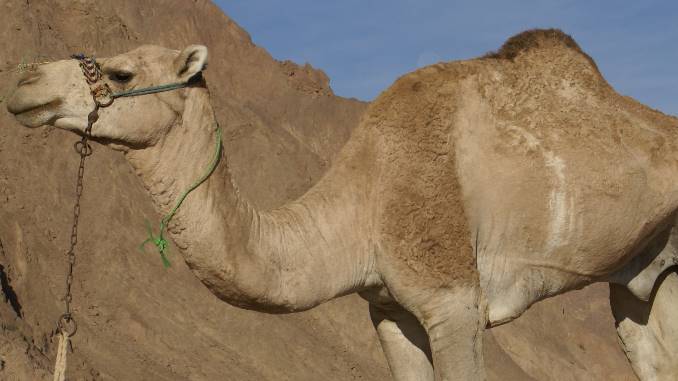
#21. Heron
Heron, also known as a great egret, large egret, or the common egret, comes from the heron Ardeidae family.
Its neck is the longest in the group of egret species. It has an S shape with white and uniformly spread feathers.
It can stretch its neck while attacking the prey via its sharp beak.
Related: Bird With Long Beak (18 Birds With The Longest Beaks)
FAQ’s
Why Do Some Animals Have Long Necks?
Do all animals have necks? Not all animals have long necks.
Why do animals have long necks? Several theories explain why some long-necked species have evolved and developed in specific ways.
The survival theory is the most prevalent. Long-necked animals, such as giraffes, share their environment with various other creatures that rely on plants and leaves for survival.
To reach the leaves on the top, giraffes developed elongated necks than other animals. This eating habit helps to reduce food competition.
Natural selection is another theory. According to some scientists, long necks serve an essential role in battling and attracting mates.
Besides, an elongated neck allows an animal to have a watchful lookout for enemies across the vast African savanna, effectively serving as a lofty sentinel.
This feature gives these animals several benefits over their competitor. Because it has a longer neck, it has more flexibility and power. Thus this body part functions as an effective weapon.
What Bird Has A Long Neck?
Many birds have long necks, such as:
- Great egret
- Heron
- Flamingo
- Jabiru
What Dinosaur Has The Longest Neck?
The longest-neck known dinosaur is Diplodocus.
Its neck could stretch over 20 feet (6m). Its lengthy tail is composed of 80 vertebrae.
Is There A Link Between Giraffes And Dinosaurs With Long Necks?
There is no connection between Giraffes and dinosaurs. Giraffes are not descended from Brachiosaurus.
Giraffes are enormous mammals, whereas Brachiosaurus was a massive reptile.
Wrapping Up
The above list has eventually shown you the most typical animals with long necks. As you can see, the length of these creatures is not the same. That’s because they have evolved with different purposes.
This part of their body helps them access food more efficiently, fend off invaders, or attract mates.

Hi, my name is John, and I’m an animal lover. I’ve been fascinated with the animal kingdom since I was 5 years old, and my passion keeps growing bigger as I age. And this blog is where I share my researches and passion with animal lovers all around the world.
